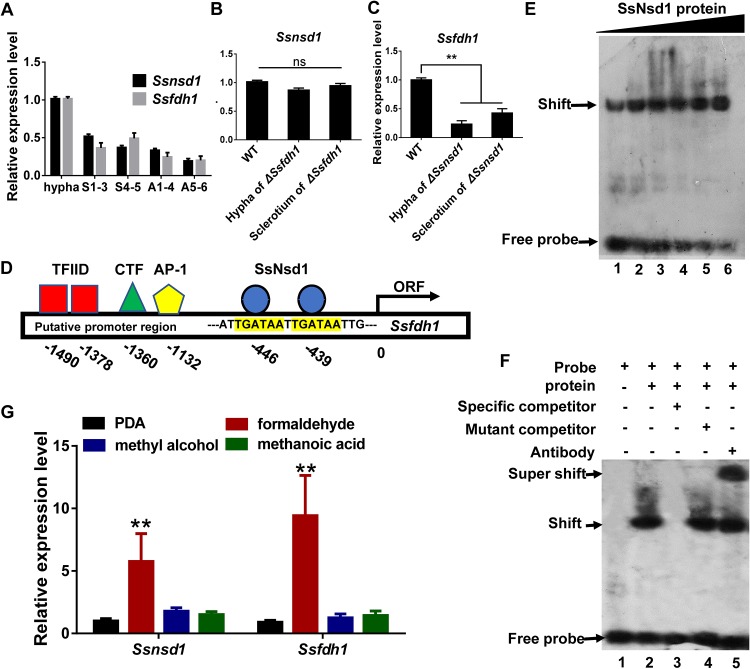FIG 3.
The transcription factor SsNsd1 regulates the expression of Ssfdh1 by binding the GATA-box region of the putative promoter. (A) The relative expression levels of Ssfdh1 and Ssnsd1 in hyphae, sclerotia (S1-3 and S4-5 stages), and apothecia (A1-4 and A5-6 stages). The constitutively expressed histone H3 gene (XM_001589836.1) was used as the reference gene to standardize data. (B) Ssfdh1 expression levels in hypha and sclerotium stages of WT and ΔSsnsd1 strains. (C) The Ssnsd1 expression levels in hypha and sclerotium stages of WT and ΔSsfdh1 strains. (D) Schematic diagram showing the predicted binding elements in the promoter region upstream of Ssfdh1 coding sequence. Predicted binding elements include TFIID (TATA transcription factor), CTF (CCAAT transcription factor), AP-1 (bZIP transcription factor), and SsNsd1 (GATA transcription factor). The transcription start sites are indicated as “0.” ORF, open reading frame. (E) Characterization of SsNsd1 GATA-binding interaction by electrophoretic mobility shift assays (EMSA). A quantity of SsNsd1 protein (500 ng, 600 ng, 700 ng, 800 ng, 900 ng, or 1,000 ng) was incubated with a 30-bp Ssfdh1 promoter probe. With the increase in the SsNsd1 amount, more DNA shift was observed with less free probe accumulation at the bottom. (F) Further confirmation of SsNsd1 GATA-box binding. The labeled DNA probe was preincubated with 500 ng SsNsd1, and then a 100-fold excess of unlabeled special competitor (unlabeled DNA probe), a 100-fold excess of unlabeled mutant competitor (unlabeled mutant DNA probe), or 1 μg anti-GATA TF commercial antibody was added. The presence or absence of the reaction content is indicated with a minus sign or a plus sign, respectively. (G) Ssnsd1 and Ssfdh1 expression levels of the WT strain in the mycelial stage of growth was tested by qRT-PCR. The WT strain was cultured on the PDA medium with formaldehyde, methyl alcohol, or methanoic acid. The histone H3 gene was used as the reference gene to standardize the data. Statistically significant differences are indicated by asterisks (**, P < 0.01 [Student's t test, n = 3]).

